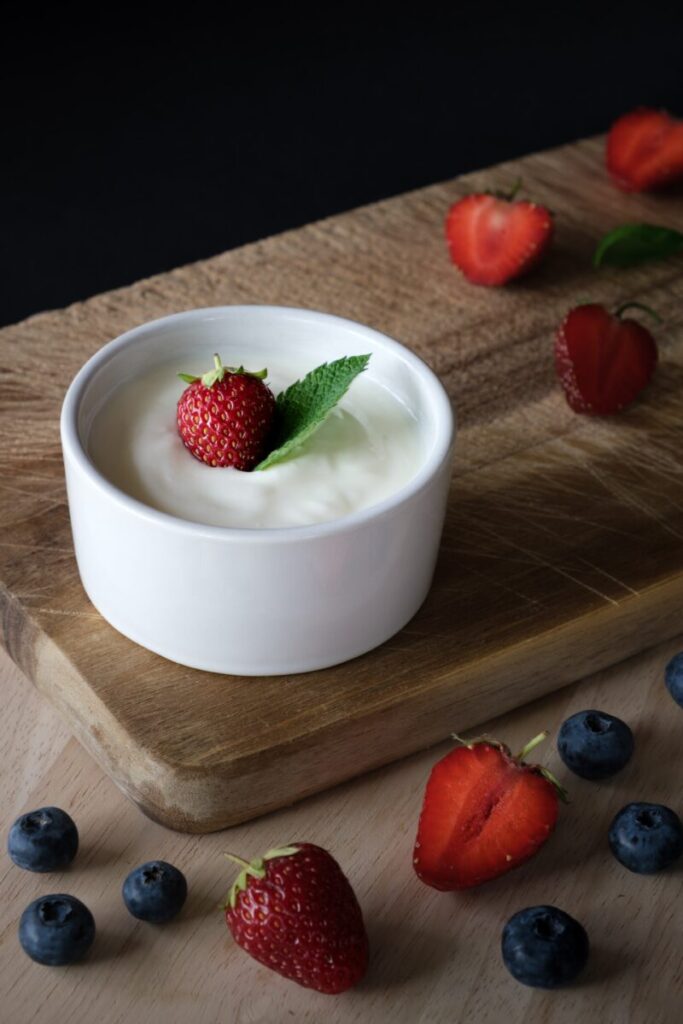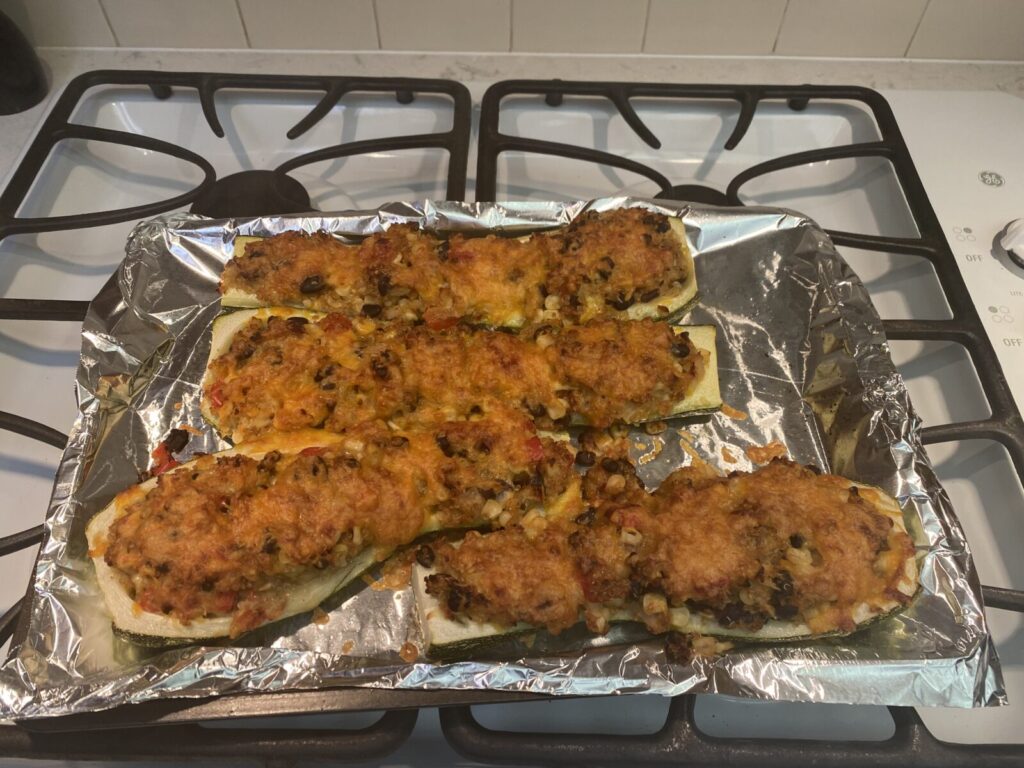Also, Quinoa Stuffed Zucchini
Have I mentioned how much I love fiber? (Rhetorical question.) It’s really one of my favorite nutrition topics to talk about. Fiber has so many valuable benefits, yet most of us don’t eat nearly enough of it. Fiber is found only in plant foods and the majority of us don’t eat enough of those, so it’s not really a big surprise.
When I talk about fiber, I should really say “fibers.” Fiber isn’t just a single thing. There are hundreds or even thousands of different kinds of fibers. Different plants contain different types of fiber. Pectins, gums, cellulose and lignans are just a few examples of some of the different types of fiber. Eating a variety of plant foods means that in addition to getting a wide range of vitamins and minerals into our diets, we’re also getting a variety of fibers.
Why does that matter?, you might ask. Does it make any difference whether we eat just one type of fiber all the time or a variety? It matters more than most people realize. Fibers are prebiotics. Prebiotics (in the simplest, most un-scientific explanation possible) are food for the bacteria that live in your gut.
Many people are aware that our digestive systems are chock-full of beneficial bacteria. After all, Americans spend over $400 million annually on probiotic supplements that presumably add more good bugs to our guts. Probiotics are beneficial bacteria that we consume directly, in the form of supplements, or fermented and cultured foods such as yogurt, miso and kombucha. These foods and supplements add billions of live and active bacteria to our systems, some of which take up residence, and others that are transient, meaning they simply pass through our system and then are excreted. (Both kinds have benefits.) So we are absolutely loaded with bacteria. Humans have roughly the same number of human cells and bacterial cells in our bodies.

Scientific opinions differ on the benefits of taking a probiotic supplement. Some doctors recommend taking a probiotic supplement during and after antibiotic treatment. Some doctors prescribe them for patients with various medical conditions, such as irritable bowel disease or celiac disease. Other doctors think they’re unnecessary. Like most supplements, if you’re a basically healthy individual and don’t have any medical reason to avoid them, a probiotic supplement probably won’t hurt you. (Every individual who lives in my house is required to take a probiotic supplement every day, including the cats. I think of it as an insurance policy to cover the days we don’t eat yogurt or consume other probiotic foods. I am not a doctor and therefore, you, dear reader, should consult with your doctor before beginning any new supplement.)
When it comes to maintaining the health of the bacteria you’ve already got, though, prebiotics are the way to go. To get into more detail, prebiotics are specialized plant fibers. They are found in fruits and veggies, as well as other plants like grains and legumes. Humans can’t digest fiber, so as it passes through our digestive system, it becomes “food” for our gut bacteria.
Now wait a minute, you’re thinking. Bacteria do not eat, nor do they have a digestive system. (At least if you paid attention in high school biology, you’re thinking this.)
No, bacteria don’t do anything as organized as eating, at least not the same way that animals do. They do, however, obtain nutrients from their environment through processes such as diffusion. Since I don’t think anyone wants to return to biology class for the specifics (I certainly don’t), for our purposes we’ll refer to what they do as “eating.”
And what do bacteria like to eat? Fiber! But here’s the problem – not all bacteria like to eat the same kinds of fibers. Just like some people like broccoli and some people don’t, some bacteria prefer pectins and others prefer gums. Or lignans. Or any of the other tons of different plant fibers out there. So if you’re eating the same foods every day, or not getting enough fiber in the first place, you might be starving some of your gut bacteria.
What can you do? Make sure you’re getting a variety of plants into your body. Include all the plant parts – leaves, fruits, seeds, flowers, roots, stems. Vary the colors. Try to get all the different plant colors into your diet each day – red, orange, yellow, green, blue/purple, white and brown. And of course, simply eat more plants. Summer brings local fruits and vegetables by the truckload, which can make it easier to get more of those plants into your diet. (If you need some help, wellness coaching is a great option.)
One summer favorite is zucchini. If you don’t have a garden full of them, your neighbor probably does, or pick some up at your farmers’ market. This recipe for Quinoa Stuffed Zucchini contains a ton of fiber from the veggies, beans and quinoa. We grow a variety of zucchini called Costata Romanesca, which is slightly bigger than other varieties, so you might have a bit of filling left over if you’re using normal-size zucchini. Summer squash works well here too.

The recipe includes roots (onion and garlic), leaves (oregano and cilantro), fruits (zucchini, tomato and bell pepper) and seeds (quinoa, corn, beans and cumin) – serve with a side of steamed broccoli or roasted cauliflower to get flowers and stems into your meal too!
Thanks for being with me on this wellness journey.


Quinoa Stuffed Zucchini
2 large zucchini
½ cup red or white quinoa, rinsed if necessary*
1 tablespoon olive oil
1 small onion, diced
1 medium bell pepper, any color, diced
1 cup corn kernels (fresh or frozen)
1 cup cooked black beans (canned is fine)
1 clove garlic, minced
1 teaspoon ground cumin
1 teaspoon dried oregano
1 cup diced tomato
1 tablespoon fresh cilantro, chopped
1 cup shredded cheese, cheddar or a Mexican blend
Preheat oven to 400 degrees. Line a baking sheet with foil.
Cut zucchini in half lengthwise. Use a spoon to scoop out the centers, leaving about half an inch all around to form a “boat.” Brush or spray the zucchini boats with olive oil and bake for 10 minutes. Remove from oven and set aside.
Chop the scooped-out zucchini flesh and set aside.
Bring 1 cup of water to a boil in a small saucepan. Add quinoa and stir. Cover and simmer for 15 minutes. Remove from heat and set aside.
Heat olive oil in a large saute pan over medium heat. Add onion and pepper and saute until onion is translucent, about 5 minutes. Add corn, beans and chopped zucchini flesh and cook for another 5 minutes. Add garlic, cumin, oregano and salt and pepper to taste. Saute for an additional 1-2 minutes. Add diced tomato and cilantro. Remove from heat.
Combine the cooked quinoa with the vegetable mixture. Mix in ½ cup of cheese.
Portion the stuffing evenly between the zucchini boats. Top each one with ¼ of the remaining cheese. Bake for 15-20 minutes, or until cheese is golden brown.
*Quinoa generally needs to be rinsed in a fine-mesh strainer before cooking. Quinoa is naturally coated with a bitter substance called saponin. It won’t hurt you, but it doesn’t taste good. Since I am remarkably lazy, I always buy Bob’s Red Mill quinoa, which is pre-rinsed. If in doubt, go ahead and rinse.

Leave a Reply